Sculpture can be an illusive medium. Sure, clay comes to mind, and, of course, that god-awful scene from the movie Ghost, but the great works of sculpture are marble and steel, right?
But primarily, when one thinks of sculpture, Renaissance-era marble statues like Michelangelo’s David and Alexander of Antioch’s Venus de Milo, usually come to mind. Or for the less historically minded, perhaps what comes to mind are works like the giant steel pieces of art surrounding the Fort Wayne Museum of Art.
Elizabeth Wamsley believes clay is just as viable as these other sculpture mediums. And why shouldn’t it be?
“My goals are to finish a commission for my gallery guy and get it to Los Angeles. [I’d like to] find a big, new studio and to work on some large sculptures. [I want to] get Northern Indiana to see clay sculpture as viable,” said Wamsley via email.
One of Wamsley’s most stunning pieces, “My Own Archeology,” is a large thrown vessel with layers of ash glaze included. With a bright blue ewer on one side, the vibrant colors of the main section (the olive greens, pale blues and yellows) definitely make the bright blue sea glass-esque side element really stand out and capture the eye. The main vase-like facet is large enough to seize an observer’s attention even beyond the colors it projects. The smooth, curved “sides” and tilt cause the eyes to linger beyond the normal length of time. This brings its talent-based creation to the forefront.
With multiple firings, “My Own Archeology” is assembled on a base of clay with pools of molten “trash” glass. It stands about 22 inches tall and 14 wide, making it big enough to be the focus of any room, but small enough so as not to overwhelm.
A similar piece, “Underwater,” evokes the same tone and feeling, but with an entirely different shape. This piece demonstrates a small vessel, a tiny urn really, caught between another vase-like element and shards of clay, layered on top of one another.
“I made [these] by layering clay slabs, and then cutting them up. The stoneware and ash [elements] are glazed and there’s some molten glass [included],” said Wamsley of this smaller piece.
Standing at just eight inches tall, “Underwater” could fit on a shelf, though it deserves its own display and lighting and wouldn’t be out of place sitting right next to “My Own Archaeology.” The colors are similar, though there are just hints of blue. It has mostly an earthy color scheme, including browns, oranges and greens, but the bits of blue and aqua tend to knock it out of the typical autumnal color spectrum and add to its uniqueness.
The colors mentioned are mostly obtained through glazing, which is a sealed layering or coating of a glass-like substance that has been fused to the ceramic through firing. The glaze can serve as a color, to decorate or to waterproof a piece. It’s important to get these terms down, as they are essential to Wamsley’s methods.
“I use clay mainly as a starting point in my artwork,” she says. “Clay has been integral for a very long time, so it is hard not to start with it. Sometimes I will mix my own clay formula or use clay from Laguna Clay or Continental Clay. I do use a potter’s wheel and elements from thrown vessels to shape some of my sculptures. I use the wheel when I’m making my more ‘functional’ forms.
“There is a lot of prep getting tools and clay prepared. I do sometimes use paper clay, to make my sculpture less weighty. That is a whole [different] process to mix up. I do some sketches, but the end results do change. I spend some days throwing forms and then assemble the parts. The forms must be dried carefully and slowly.
“Generally I do two or more firings depending on my ideas,” she adds. “Glazing the forms takes time, and I do mix up most of my glazes. Sometimes I will soak my pieces in a soda ash solution, let them dry and then glaze. Once my sculptural pieces are fired I will begin to assemble them, if necessary. I save shards from previously destroyed work and will use these in my work [see ‘Underwater’]. I have used firebrick and broken kiln shelves, wire and fencing wire.”
You can find Wamsley’s art, which is highly varied and shouldn’t be defined simply by the pieces described here, at Crestwoods Gallery in Roanoke, Carmel Art on Main Gallery in Carmel and, through December 24, at the Art Studio Holiday Gallery at Jefferson Pointe.
The two aforementioned pieces sit definitively in the fine art realm, and could really have no other function, though their worth as art pieces is entirely enough.
Two other pieces, both entitled “Oceanic Vessel,” could easily stabilize giant sunflower stalks or a bouquet of roses, though they might look a little antique while supporting new, fresh flowers.
This appearance of antiquity is a testament to Wamsley’s skill. These two pieces would appear to have been created a century or two ago rather than something created this century. The two urn-like vases combine both clean, smooth elements and textured, gnarled segments which keep the viewer’s visual sense and attention piqued.
Where these two pieces really shine is the textured, rough handles that adorn each side and the painted decorations inscribed around the widths.
The shorter of the two features rudimentary yet somehow emotional fish on top of a graveyard of vases and urns. The taller, more dominant of the two has vases and urns painted on, making the piece existential and meta which is not something you usually hear in regards to “sculpture.” This again is a testament to Wamsley’s talent and the way she works through clay and glass to create her art.
Sculptors and those who work with more abstract themes cannot always convey exactly what they want through their art. It requires the observer’s interpretation to flesh out meaning and purpose.
Wamsley understands this, and urges people to support original art by visiting galleries and attending art receptions.
“Sometimes art is difficult to understand,” she says. “Educate yourself and begin to question why some artwork bothers you.”


